A coherent journey through maths
At a small, rural primary school, pupils in mixed-age classes benefit from teaching for mastery approaches

The school context
Scotton Lingerfield Primary School is a small rural school near Knaresborough in North Yorkshire. With just 105 pupils on roll, the school is organised into four mixed-age classes: EYFS, Year 1/2, Lower KS2 and Upper KS2. The school has low percentages of SEND and FSM pupils.
Yasmin Alvarez is maths lead and teacher of a mixed Year 5/6 class. Since taking on the role of maths lead in 2019, she has worked closely with Yorkshire Ridings Maths Hub, taking part in Developing, Embedding and Sustaining Work Groups, as well as a Research and Innovation Work Group (RIWG) focused on mixed-age teaching. She is now training as a Primary Mastery Specialist.
The classroom challenge
Before implementing the two-year rolling programme, the school’s approach to teaching maths in mixed-age classes was placing considerable pressure on staff and limiting pupil progress. Teachers were planning and delivering two separate maths lessons each day to cover the curriculum for both year groups.
This reduced the time available for pupils to explore mathematical ideas. In Key Stage 2, pupils couldn’t discuss or reason about their maths in depth, as teaching time was split. Teachers found it difficult to keep track of learning while switching between objectives. Although the school was using the NCETM Professional Development materials, the shortened maths sessions in KS2 and logistical challenges meant they weren’t being used to their full potential.
Overcoming the challenges
Adopting the NCETM two-year rolling programme in KS2 marked a turning point. The approach allowed teachers to plan and deliver one coherent lesson per day, giving pupils more time to think, talk and understand. It also supported the school’s commitment to teaching for mastery, enabling teachers to embed the Five Big Ideas into everyday practice and enhance their own subject knowledge.
Access to high-quality professional development was key. Yasmin and her colleagues attended Teaching for Mastery Work Groups through the Maths Hub, where they received expert guidance and were able to share ideas and best practice with colleagues from other schools.
Time for in-school collaboration was also essential. Teachers took part in regular professional development meetings and worked together to plan and teach lessons. These sessions began during initial implementation and have continued ever since.
The school recognised that embedding mastery was a long-term process. Ongoing CPD and time to discuss and refine the rolling programme have helped staff implement it with increasing confidence and precision.
The overall impact
Since introducing the mastery approach, the school has seen measurable improvements. The average scaled score in Year 6 has risen by 7 points, and the proportion of pupils achieving Greater Depth has increased from 25% to 50%.
Teachers report that the two-year rolling programme has helped reduce workload while also improving subject knowledge. Staff now approach teaching for mastery with greater confidence, and pupils are more articulate and flexible in their thinking. Their understanding is secure, allowing them to build on prior learning and make strong progress.
Watch a short video interview with Yasmin and headteacher Debbie Calvert, as they share their experience of implementing the two-year rolling programme in mixed-age classrooms:
Start your own school journey
Schools with mixed-age settings can access planning resources and leadership videos by engaging in the Teaching for Mastery Programme with their local Maths Hub. These materials are designed to support leaders and teachers at every stage of their journey.
Ready to get started?
Explore the rest of the mixed-age content on our website, and contact your local Maths Hub to discover the support available in your area.
